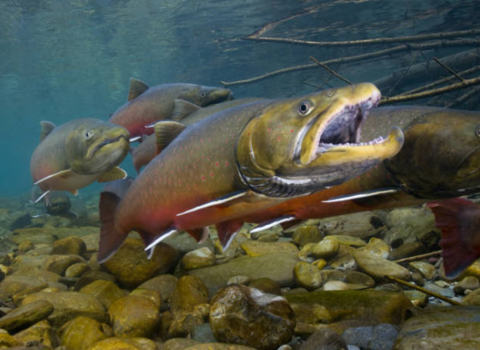Willapa Bay and the Long Beach Peninsula may be a remote stretch of southwest Washington shoreline, but the area is a veritable six-lane highway of shorebird migration.
Because of the area’s importance to conservation, the Western Hemisphere Shorebird Reserve Network (WHSRN) has designated it as a Site of International Importance.
Willapa Bay and the Long Beach Peninsula comprise the 97th site in a network of critical areas for shorebirds in 15 countries, stretching from Tierra del Fuego in Argentina to the Arctic. The bay and peninsula join two other nearby WHSRN sites along the Washington coastline: the Columbia River Estuary to the south, and Grays Harbor to the north.
The area plays a critical role as a stopover point for an estimated 200,000 to 300,000 shorebirds each spring. Short-billed dowitcher, red knot, and dunlin pass through in numbers at 10 percent or more of their Pacific Coast populations. Within the area of designation is Willapa National Wildlife Refuge, which includes thousands of acres of mudflats, beaches, and sand dunes.
“Shorebirds undertake some of nature’s longest migrations. Their ability to travel thousands of miles depends upon a network of critical sites along the way, where they can rest and refuel,” said Rob Clay, WHSRN Director. “We are thrilled to recognize Willapa Bay and the Long Beach Peninsula for the important habitats they provide birds between their breeding grounds and overwintering sites.”
Added Jackie Ferrier, project leader at Willapa National Wildlife Refuge: “This is quite an honor to be recognized for our importance to bird conservation. The refuge and Long Beach peninsula offer tremendous habitat for the birds, which translates into exceptional viewing opportunities for the public. We hope this official designation brings additional attention to the importance of the Washington coast and Willapa National Wildlife Refuge for wildlife.”
This region represents the largest area of tidal mudflat and coastal salt marsh salt marsh
Salt marshes are found in tidal areas near the coast, where freshwater mixes with saltwater.
Learn more about salt marsh habitat in southwestern Washington and the second largest estuary on the Pacific coast of the United States. Willapa Bay’s waters recede at low tides to expose nearly 50,000 acres of mudflats with abundant foraging opportunities, while the 27-mile Long Beach Peninsula provides beach and dune habitats for up to 50,000 shorebirds during high tide.
In addition to linking key habitat along shorebird migration routes, the site designation also recognizes the efforts of 14 stakeholders including landowners, conservation groups, private businesses, and state and federal agencies around Willapa Bay and the Long Beach Peninsula.
Current conservation actions in the area include a multi-partner invasive species invasive species
An invasive species is any plant or animal that has spread or been introduced into a new area where they are, or could, cause harm to the environment, economy, or human, animal, or plant health. Their unwelcome presence can destroy ecosystems and cost millions of dollars.
Learn more about invasive species eradication program. This effort has resulted in the almost complete elimination of nearly 8,000 acres of non-native cordgrass (Spartina alterniflora), restoring significant portions of estuarine habitat for shorebirds and other native wildlife. Partners are also working to build a constituency of support for shorebirds with student art. Local youth created artwork that has been transformed into shorebird educational signs installed along beach and bay access areas.
The WHSRN designation and community engagement activities at Willapa Bay and Long Beach Peninsula are part of a larger North American project, Arctic Migratory Birds Initiative (AMBI)—the Americas’ Flyway Action Plan, led by the Commission for Environmental Cooperation (CEC). The CEC AMBI project is working to identify and designate important sites for red knots and semipalmated sandpipers, and to engage the communities at these sites in Arctic-nesting shorebird conservation. CEC is a tri-national organization dedicated to the protection, conservation, and enhancement of North America’s environment.
The public is invited to attend a site designation ceremony and student art exhibit on International Migratory Bird Day. The free event will be held from 2-4 p.m. May 13 at the Columbia Pacific Heritage Museum in Ilwaco, Wash.
